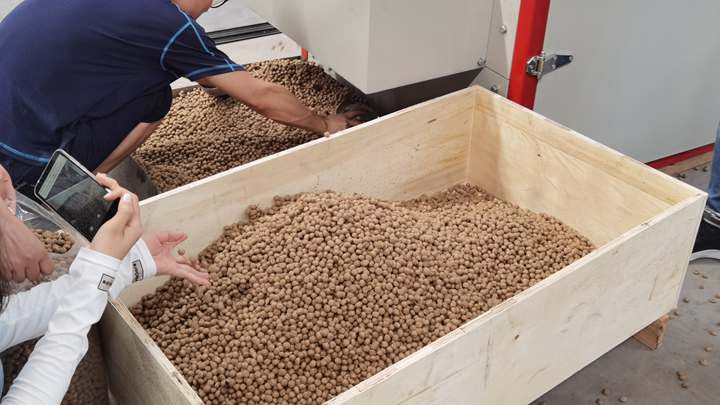.jpg)
Jan 30, 2018 · Abstract Juvenile rainbow trout (125 ± 0.8 g) were fed a fishmeal control diet (C), a high soy protein concentrate diet (SP), a high soybean meal diet (HiS), or a diet with high levels of
.jpg)
High quality High Efficiency Floating Fish Feed Extruder Pellet Machine Dry Type from China, China's leading fish food extruder machine product, with strict quality control animal feed extruder factories, producing high quality animal feed extruder products.
.jpg)
Sep 16, 2018 · It was noted that moisture content constituted a greater portion of variability in efficiency than speed. Muo et al. (2018) also designed and fabricated a fish feed pelleting machine which has a
.jpg)
Aug 21, 2019 · Within the experimental diets, fish fed the 400 g kg-1 soy flour diet and the 400 g kg-1 soybean meal diet had significantly higher weight gains (276% and 268%) and protein efficiency ratios (2.58
.jpg)
Mar 2, 2009 · The WF2 diet was ranked as the least expanded diet, resulting in a significantly higher bulk density for this diet compared the other three diets (Table 3). Combining the information from the loading plot ( Fig. 4 a) and the score plot ( Fig. 4 b) showed that the longer WF1 pellets mainly was correlated to a higher die temperature and SME.

Jun 12, 2021 · Eating disorders are directly or indirectly influenced by gut microbiota and innate immunity. Probiotics have been shown to regulate gut microbiota and stimulate immunity in a variety of species. In this study, three kinds of probiotics, namely, Lactobacillus plantarum, Lactobacillus rhamnosus and Clostridium butyricum, were selected for the experiment. The results showed that the addition of
.jpg)
The present invention relates to a kind of largemouth bass expanded pellet diets of ultralow starch, comprise the following components in parts by weight: day 25-28 parts of the same level fish meal, 18-30 parts of Rofe fish meal, 5-15 parts of krill meal, 5-9 parts of fermented bean dregs, 3-7 parts of dried porcine saluble, 5-9 parts of Strong flour, 1-2 parts of calcium dihydrogen phosphate
.jpg)
Oct 1, 2022 · In summary, up to 100 % of SBM and RSM can be replaced by FBM in expanded pellet diets without any adverse effects on the growth performance, but decreased muscle crude lipid content, and increased protein efficiency ratio, collagen content, H 2 O 2, free amino acids, texture properties and the mRNA expressions of col1α1 and col1α2 genes in
.jpg)
The invention discloses a kind of raw fish expanded pellet diet, composition includes fish meal, dregs of beans, blood meal, brewex's grains, Gluten, flour, fish oil, soybean oil, soyabean lecithin oil, cholesterol, methionine, lysine, bile acid, vitamin premix, mineral substance premix, glycine betaine, choline chloride.The feed passes through reasonable component proportion, meet whole
.jpg)
Different Types of Fish Pellets Explained!!!! I just wanted to try and help a few people understand the difference between the 2 types of feed you can buypelletised and extruded, pelletised pellet has been compressed very tightly to get the shape whilst extruded pellet goes through a more complex costly system to achieve the structure []
.jpg)
pellet Steam-treated compressed pellet line Floating / slow sinking Best water stability; best FCR; many anti-nutritional factors removed with heat. Extruders more expensive and so high production cost. Requires more skill in production. Fish feeding can be observed. 10% Extruded/Expanded pellet Extruded/expanded pellet line
.jpg)
Aug 26, 2019 · The goal of this research was to study the physical quality of fish pellets containing 70% plant-based proteins (CMM, CM and ISP), 10% binders (WGP and GG) and about 20% fish-based protein (vitamin premix, fish oil and fishmeal) for potential rainbow trout feed.
.jpg)
Apr 1, 2023 · In the same processing, protein efficiency ratio of largemouth bass fed extruded diet were higher than the pelleted diet. The protein requirement of extruded diet and pelleted diet for largemouth bass were 48.28–53.36% and 49.02–54.18% .
.jpg)
Jun 25, 2019 · Today, the two most widely used technologies for the manufacture of aquaculture feed are pelletisation and extrusion. Feed produced with these processes is denser, has lower moisture content and allows better preservation.
.jpg)
As the pellets are pushed out into ambient temperature, the steam expands and evaporates forming the classic expanded “honeycomb” type pellet. Average temperature is 120°C to 150°C. We have found that, in most cases, expanded pellets give several significant improvements when compared to traditional, compression pellets.